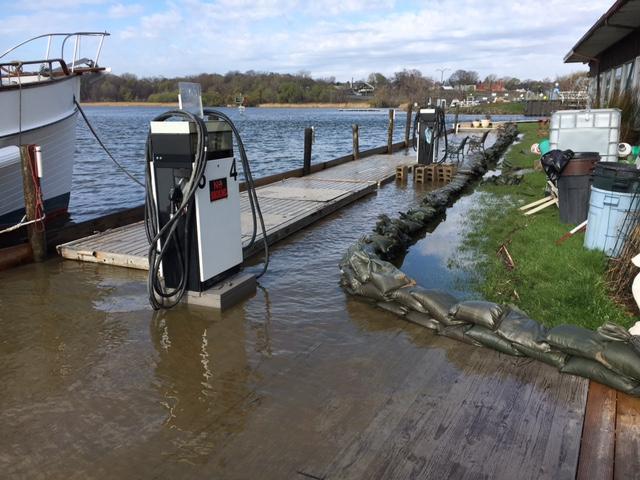
Flooded gas dock at Mayer’s Marina. Image: Alex Crichton
By Veronica Volk
This story originally appeared on Great Lakes Today and is republished here with permission.
Lake Ontario is nearly a foot and a half higher than is usual for this time of year, and New Yorkers living on the south shore are anxiously watching the water continue to rise.
Near Rochester, the village of Sodus Point is providing sandbags to homeowners.
They’re stacking bags along the edges of their land, hoping to hold back the rising lake.
And at Mayer’s Marina on Irondequoit Bay, water was encroaching on a gas dock.
Allison Mayer, whose family runs the marina, said the rising water puts her livelihood at risk. “Instead of fixing our docks, we’re filling sandbags because we’ve got land that’s covered in water, a gas dock covered in water, and it’s coming up on our sea walls and into our yards.”
Keith Koralewski with the U.S. Army Corps of Engineers says these high levels can be chalked up to weather.
“The biggest factors” Koralewski says, “have been the wet spring that we have had, including rainfalls just within the past few weeks.”
But some residents fear the cause is a new Lake Ontario management plan that took effect in January. That plan was set by the International Joint Commission, which helps to regulate U.S.-Canada boundary waters.
Lake Ontario’s water levels are managed through a dam on the St. Lawrence River, and the new plan allows more fluctuation. The plan was designed to more closely mimic natural fluctuations, and to help restore wetlands and other wildlife habitat.
On Friday, Monroe County Executive Cheryl Dinolfo called on the International Joint Commission to take immediate action. She said she sent an official request for assistance from both state and federal elected officials.
“We’re asking that our federal representatives take action, to immediately lower the water levels and to also provide the necessary resources so that our infrastructure, our businesses and our property owners, including our homeowners are protected along the shorelines of Lake Ontario, ” she said.

Sand bags for residents of Sodus Point. Image: Veronica Volk
Koralewski says because of the heavy rain, this year would likely have seen higher than average levels regardless of the new plan’s implementation.
The agency predicts Lake Ontario will be almost a foot higher by this time next month, which residents fear will overwhelm their sewer system and threaten public health.
The rising waters have prompted officials in counties near Buffalo and Rochester to declare a state of emergency.
Officials said they expect higher than normal water levels over the weekend — with a possibility of flooding.
Jonathan Schultz, director of emergency services in Niagara County, says there’s been minor to moderate flooding in some areas. But the county is still using caution.
“We’ll be working on hauling in sand and we’ll start building sand bags to start protecting overlying areas and critical infrastructure,” he said.
